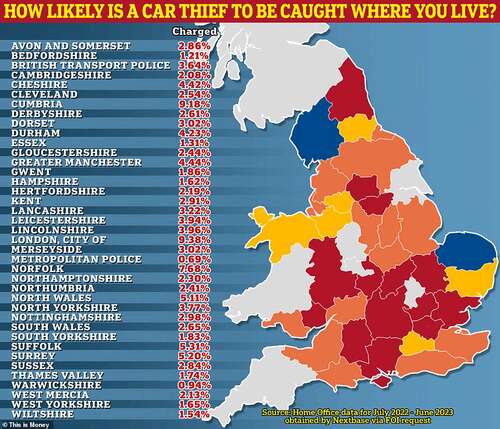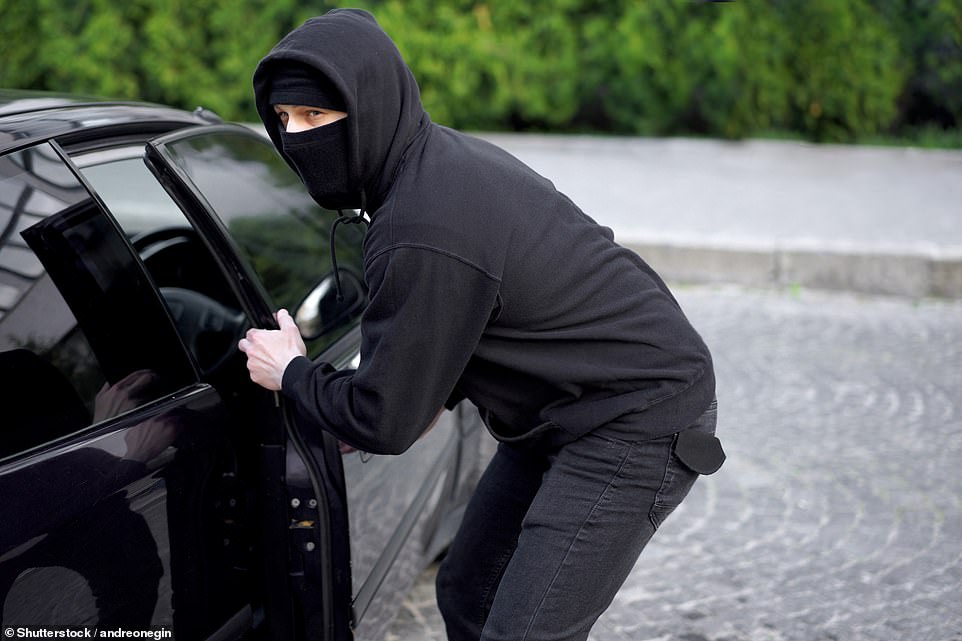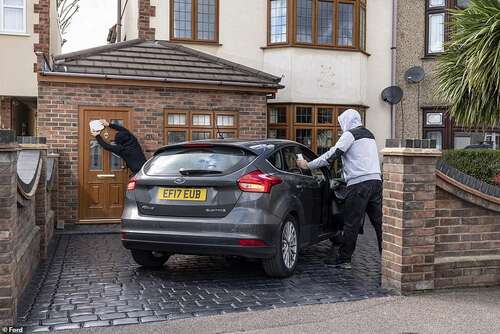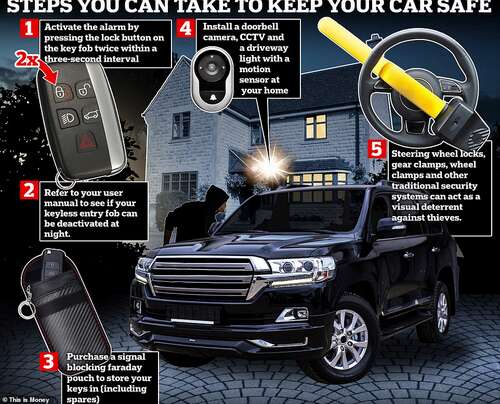Car thieves are almost certain to evade the police and avoid criminal charges in England and Wales, shocking new figures reveal.
Official data shared with This is Money suggests forces across the country are failing miserably at catching those responsible for stealing an increasing volume of vehicles from our streets, which in turn has sparking a big jump in insurance premiums for all drivers.
The nation’s motorists have been under a siege of rising motor crime in recent years, which has been triggered by organised and well-funded gangs using hi-tech tactics to infiltrate the security systems of keyless cars.
New government figures show the number of offenders charged for motor theft account for just 2 per cent of cars stolen between July 2022 and June 2023 – and in London, it’s all but decriminalised due to the Met’s difficulties catching thieves.

This map shows the average charge rate police secure for car thefts in different parts of England and Wales between July 2022 and June 2023. The Home Office figures suggest there’s little chance of police catching individuals who steal motors
The figures on car thefts and criminal charges relating to them have been supplied by the Home Office to dashcam maker Nextbase following a freedom of information request.
It shows that the charge rate for vehicle thefts in England and Wales steadily declined throughout the 12-month period reviewed, from 2.8 per cent in July 2022 to just 1.43 per cent in June 2023.
In total, there were 104,678 reported vehicle thefts in timeframe analysed.
However, only 2,215 individuals faced criminal charges, which is an average rate of only 2.12 per cent.
One of the big issues is that the organised criminal gangs behind the rise in motor thefts have become so proficient when using a wealth of new complex tactics and expensive tech, their getaway is so rapid that police forces across the country are struggling to get a grip on the escalating problem.
The problem with tracking down thieves is most acute in London, with the Met Police making charges in just 214 cases from a total of 31,200 reports of stolen vehicles in the year.
This is a measly average charge rate of 0.69 per cent – the lowest of any region that supplied data.
The City of London, which primarily covers the small central business district, is reported separately as it is enforced by City of London Police and not the Met.
Just 32 vehicles were reported stolen in the City of London during the period analysed, with a total of three charges for individuals.
London as a whole was also the area with the most car thefts, followed by Manchester – with 7,656 thefts, 340 charges and a charge rate of 4.44 per cent – and West Yorkshire, which saw 5,992 motors stolen and only 99 criminals charged (a charge rate of 1.65 per cent).
These are the areas where motorists are facing the highest premium prices for insurance, with Inner London motorists quoted £1,607 on average and Mancunians £1,233, according to the latest quoted data from Confused.com.

New Government figures show that just 2% of thefts between July 2022 and June 2023 resulted in an offender facing charging – and in London, it’s all but decriminalised due to the Met’s difficulties catching thieves
If you are reading this story on the MailOnline app and unable to see the table directly below, click this link to see the full results in a web browser
| AREA | NUMBER OF VEHICLE THEFTS JULY 2023 – JUNE 2022 | NUMBER OF INDIVIDUALS CHARGED IN RELATION TO VEHICLE THEFTS | % CHARGED |
|---|---|---|---|
| Avon and Somerset | 2,695 | 77 | 2.86% |
| Bedfordshire | 1,483 | 18 | 1.21% |
| British Transport Police | 495 | 18 | 3.64% |
| Cambridgeshire | 1,391 | 29 | 2.08% |
| Cheshire | 927 | 41 | 4.42% |
| Cleveland | 1,219 | 31 | 2.54% |
| Cumbria | 294 | 27 | 9.18% |
| Derbyshire | 1,568 | 41 | 2.61% |
| Dorset | 1,025 | 31 | 3.02% |
| Durham | 1,016 | 43 | 4.23% |
| Essex | 5,273 | 69 | 1.31% |
| Gloucestershire | 532 | 13 | 2.44% |
| Greater Manchester | 7,656 | 340 | 4.44% |
| Gwent | 862 | 16 | 1.86% |
| Hampshire | 3,085 | 50 | 1.62% |
| Hertfordshire | 2,051 | 45 | 2.19% |
| Kent | 3,261 | 95 | 2.91% |
| Lancashire | 2,270 | 73 | 3.22% |
| Leicestershire | 1,955 | 77 | 3.94% |
| Lincolnshire | 758 | 30 | 3.96% |
| London, City of | 32 | 3 | 9.38% |
| Merseyside | 2,749 | 83 | 3.02% |
| Metropolitan Police | 31,200 | 214 | 0.69% |
| Norfolk | 508 | 39 | 7.68% |
| Northamptonshire | 914 | 21 | 2.30% |
| Northumbria | 2,405 | 58 | 2.41% |
| North Wales | 352 | 18 | 5.11% |
| North Yorkshire | 504 | 19 | 3.77% |
| Nottinghamshire | 1,982 | 59 | 2.98% |
| South Wales | 1,846 | 49 | 2.65% |
| South Yorkshire | 5,083 | 93 | 1.83% |
| Suffolk | 452 | 24 | 5.31% |
| Surrey | 1,885 | 98 | 5.20% |
| Sussex | 2,115 | 60 | 2.84% |
| Thames Valley | 3,739 | 65 | 1.74% |
| Warwickshire | 1,176 | 11 | 0.94% |
| West Mercia | 1,410 | 30 | 2.13% |
| West Yorkshire | 5,992 | 99 | 1.65% |
| Wiltshire | 518 | 8 | 1.54% |
| Total | 104,678 | 2215 | 2.12% |
| Source: Home Office data for July 2022 – June 2023 obtained by Nextbase via FOI request | |||
This is Money contacted Met Police for comment.
A spokesman told us: ‘The Met recognises the impact that motor vehicle crime can have on victims, especially those who rely on vehicles for either means of employment or the routine of daily life.
‘Any allegation of crime reported to the police will be assessed to see if there are any viable lines of enquiry including forensic opportunities that can be progressed.
‘A New Met for London sets out how we will deliver better policing as we radically transform the organisation to set our officers and staff up to succeed. We want Londoners to know their local officers and work with them to help shape their policing priorities, to reduce crime and to tackle other areas of concern.
‘However, there are several measures that motorists can take to protect their vehicles and their contents such as fitting a steering lock which can act as a visible deterrent and removing valuables or ensuring they are not left on display.
‘Additional crime prevention advice can be found via our website https://www.met.police.uk/cp/crime-prevention/keeping-vehicles-safe/preventing-car-vehicle-theft/.’

ABI figures show how much the average motor insurance policy has increased in the last two years. It said this was a result of a rise in claims, many of them around thefts

The ‘Relay Attack’, where criminals duplicate the signal of a car keyfob inside the vehicle owner’s property to unlock the doors and then drive away, is one of a raft of new hi-tech tactics used by criminals to pinch motors, and is the driving force behind the rising levels of this type of crime
The increase in theft-related vehicle claims sent car insurance costs spiralling for almost all drivers across Britain last year, the Association of British Insurers said last month.
It said the average car insurance premium rose 25 per cent in 2023, rising to £543 up from £434 in 2022.
Meanwhile the typical driver paid £627 to insure their car in the final quarter of 2023, a rise of 12 per cent on the previous three months showing costs continuing to balloon.
Ben Pearson, a former police interceptor and traffic officer, sympathised with police and said car owners need to do what they can to ensure their vehicle remains secure.
‘Today’s car thieves are sophisticated professionals, not teenagers out for a joy ride,’ Ben explains.
‘By the time police are alerted to a theft a car could already be out of the country, or in a garage somewhere being stripped for parts.
‘What they need to stop this epidemic is more evidence – and dash cams are crucial to that.’
According to the latest ONS data, vehicles thefts were up 8 per cent annually to 132,489 cases between October 2022 and September 2023.
Speaking exclusively to This is Money last month, Steve Launchbury, principal security engineer at automotive risk intelligence company Thatcham Research, said the recent rise in thefts is the result of organised criminality, with ‘sophisticated criminal gangs directing significant resources towards seeking out car security vulnerabilities’.
With police resources stretched, Launchbury says premium vehicle thefts – such as Range Rovers – present a profitable and relatively low risk option for thieves.
‘The internet and social media platforms also offer the opportunity for the sharing of vulnerabilities to wide criminal communities, in an instant. Digital devices with valid primary functions are also being reverse engineered for criminal means and can be easily found and purchased online,’ he tells us.
‘Many manufacturers have implemented effective counter measures, making vehicles with keyless entry systems more resilient to the so-called relay attack.
‘As a result, more recently launched models are less susceptible to this theft technique.’
Police are failing to charge people in the vast majority of cases because they lack evidence, Nextbase says.
In fact, police reports cited ‘evidential difficulties’ or ‘investigation complete: no suspect identified’ in 98 per cent of cases.
Bryn Brooker, head of road safety at Nextbase, said: ‘Criminals would not be stealing this many cars if they had a higher chance of getting prosecuted.
‘Police do what they can but are stretched and need your help, especially given the vulnerabilities of some modern cars to relay theft.’
Only Devon & Cornwall, Dyfed-Powys, Humberside, Staffordshire, and West Midland were unable to respond to the FOI issued by Nextbase.
Scotland was not included in the study because it uses another method of calculating charge rates that is not comparable.

These are the 10 model stolen car models throughout 2023, according to official DVLA data. The red figure shows the total number of reported thefts for each and the blue percentage is the increase/decrease compared to 2022
Do you own one of the 10 car models most at threat?
DVLA figures exclusively provided to This is Money show that Ford’s Fiesta was the most stolen car of all last year, with 5,976 taken from owners in 2023.
Second in the list of most-pinched models was the Ford Focus (2,120), followed by the VW Golf (2,038) and Mercedes-Benz C-Class (1,786).
Jaguar Land Rover (, which has been the focus of attention of media reports surrounding the rising number of thefts in recent years, has seen vehicle thefts decline in the previous 12 months.
Its Range Rover Sport was fifth in the list (1,631) of most stolen cars, followed by the smaller Range Rover Evoque (1,489).
However, the DVLA data shows that the number of Range Rovers stolen across all models (also including Range Rover and Range Rover Velar) declined by around 20 per cent year on year.
This is likely a result of the brand’s recent decision to spend £10million retrofitting older models dating back to 2018 with its latest security technology.
The British car maker confirmed to This is Money that this investment has now risen to around £15million as older versions of as far back as 2016 are now eligible for the free upgrade – that accounts for around half a million of its cars across the JLR brand.
HOW TO BEAT THE CAR THIEVES: Experts reveal 15 top tips to protect your vehicle
This is Money has spoken to a number of experts across the field of vehicle security to create a list of 13 tips all car owners should follow to best protect their motors.
We’ve enlisted the help of Thatcham Research, AA President Edmund King and vehicle crime consultant Dr Ken German – previously head of technology at the Met stolen car squad with a PhD in International Vehicle Crime – to compile the ultimate list of car security tips:

1. If your car has keyless tech, buy a Faraday pouch to keep it in
A signal blocking faraday pouch will prevent thieves from being able to duplicate the signal from your keyfob stored in the house. Make sure the pouch is designed specifically for keys and test it by inserting your fob into the pouch and attempting to open your vehicle.
2. Find out if your keyless car fob can be deactivated
Refer to your user manual to see if your keyless entry fob can be deactivated at night.
You should also check that you have a motion-sensor enabled fob, which goes to sleep when idle (i.e., when stored at home). Most vehicle manufacturers now produce this type of fob.
3. Make sure your car is locked in the first place
This may seem obvious, but a large proportion of thefts are a result of the vehicle being left unlocked or criminals using signal jammers that block your key fob from communicating with the car’s locks.
Drivers should always check the vehicle is locked and the windows are up after using a key fob. Listen for the locking noise and watch for the lights to flash and – if your car has them – automatic wing mirrors to fold.
4. Don’t leave your car engine running to defrost windows
Freezing temperatures can tempt drivers into starting the car’s engine to deice or defrost the windows, then returning to the warmth indoors until the windscreen is clear.
It might sound obvious but by leaving a vehicle unattended is a huge security risk, even if it’s on your own private driveway. In fact, it is illegal to do this, and your insurer is unlikely pay out for any loss if your car is stolen as a result of this.
Thieves will be checking for stationary cars emitting exhaust smoke or that have wing mirrors that normally are folded in when locked but are clearly not.
5. Keep valuables out of sight
‘Out of sight, out of mind’. Remove all valuables from your vehicle to make it less of a target to opportunistic thieves.
6. Do you have an alarm and immobiliser?
Ensure your vehicle has a Thatcham-certified alarm, immobiliser and tracking system fitted. Some insurance policies require the fitment of a tracking device, so it’s important any associated subscriptions to monitoring services are maintained.
7. Mechanical security systems – like a steering lock – might seem ‘old hat’ but are a great deterrent
Steering wheel locks, gear clamps, wheel clamps and other traditional security systems can act as a strong visual deterrent against thieves.
8. Install a doorbell camera or CCTV at your home
Doorbell cameras and CCTV systems are becoming increasingly popular as both a deterrent for car crime and to catch thieves.
Make sure you invest in one that has a night vision mode and crisp HD resolution.
Motion-sensing driveway lighting can also be a strong deterrent.
9. If you have a garage, use it!
If you have a garage, try to make sure there is enough room for your car to fit into it, rather than using it for storage for all types of household clutter.
If you have multiple vehicles, almost prioritise the garage for the one of highest value – and park another car in front of the garage door as an extra precaution.
And if you have electric garage doors, do not keep the transponder inside the vehicle, such as in the glovebox. Victims have subsequently found this to be the reason for their property being burgled.
10. Think about where and how you park overnight
Most car thefts take place under the cloak of darkness, so this is the most important time to consider how secure your vehicle is.
If you don’t have a garage but do have a driveway, always park tactically.
For instance, if you have a big driveway, park the car sideways to so any thief will need to manoeuvre it. If your driveway is smaller, park facing your house to increase the chances of you being alerted to the lights coming on. And park with the wheels turned on full lock to extend the time it takes for criminals to make a getaway. Even consider parking another less desirable car in front (or behind) your vehicle to prevent easy removal.
Those with driveways can also purchase lockable barriers to restrict access – and experts advise that a car cover is often a deterrent due to the time it takes to remove one and will look suspicious to neighbours and passersby.
If you do not have off-street parking, try to leave your car in a well-lit area – ideally with CCTV monitoring – and in a position that makes it difficult for a thief to move quickly.
Ken German tells us that some motorists are being extra inventive in their bid to protect their cars. Some previous victims are leaving mannequins in the driver’s seat to dissuade unwanted visitors.
11. Check repair centre and bodyshop accreditation to avoid key cloning
If you need to leave your key with a garage or bodyshop, you should check that they are a member of an accredited code of practice/professional standard such as The Motor Ombudsman or The British Parking Association’s Park Mark scheme.
This should reduce your chances of falling victim of key cloning.
Also, if you have purchased your vehicle second-hand with only one working key, visit an approved repair centre to have the missing key(s) deleted and add a spare as soon as possible.
12. Consider a dashcam or a car with theft alerts
Dashcams have grown in popularity in recent years, with motorists primarily using them to prove they were not at fault in a crash.
They also act as a great theft deterrent. This is because many of these devices will also record suspicious activity around your car is parked up and you’re not in it.
However, make sure you buy one that uploads videos to cloud storage rather than saving it only a memory stick in the dash cam – because you will also lose this if your car is stolen.
Some modern vehicles now offer ‘parking mode’, which also can also detect and record movement when parked. This can be used as supporting evidence by your insurer and the police.
Many of these alerts will be powered via a smartphone app, so ensure you’ve activated the feature and turned on notifications.
13. Always wipe stored info from a car before you sell it
Some vehicle apps and connected systems can provide the previous owner with access.
If permissions remain active, ensure that all permissions and data linked to the previous owner are wiped.
14. ‘Locust’ thieves might strike twice
A new wave of ‘locust thieves’ exist today who strip cars whilst they’re parked at the side of the road and even outside owners’ homes.
Many people have woken up to find wheels, bonnets and grills and even doors missing from their cars rendering them undriveable. This is because these parts are becoming more valuable since the pandemic with factory closures and slowdowns meaning some components are not as readily available from manufacturers as pre-Covid.
For instance, a Porsche headlight can be worth up to £1,000 today, which has driven a rise in these parts being stolen. Wing mirrors for top of the range vehicles are also easy-to-steal high-value components.
Ken German warns that falling victim to locust thieves might not be the end of the story. He says owners who have had parts pinched from their car should check around and under the vehicle to ensure thieves have not fitted a tracking device so they can track when the motor is not being used and return at a later date to attempt to steal it.
15. Be aware of scam crash tactics deployed to steal cars
While carjacking still exists today, it is not as prevalent in the UK as it is in some other countries, such as South Africa.
That said, if you are in a high value vehicle you would be wise to drive with the doors locked in traffic.
Also drive defensively when in a queue leaving enough space in front for you to get out of a tight spot should you need to.
If your vehicle is bumped from behind, wait to pull over and find somewhere safe where there are people. If you’re suspicious don’t unlock the door and call the police.
VIDEO
![]()
BEST OF MOTORING
Some links in this article may be affiliate links. If you click on them we may earn a small commission. That helps us fund This Is Money, and keep it free to use. We do not write articles to promote products. We do not allow any commercial relationship to affect our editorial independence.



